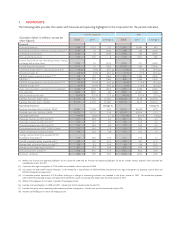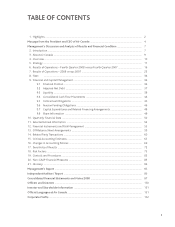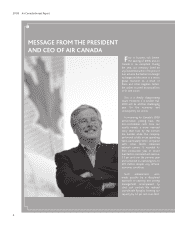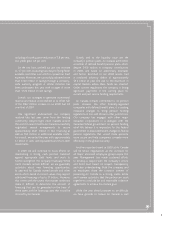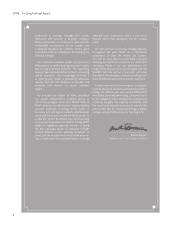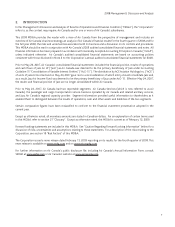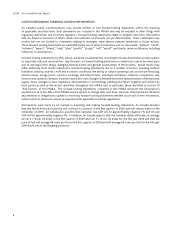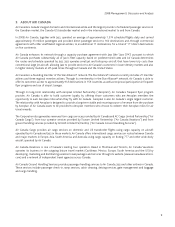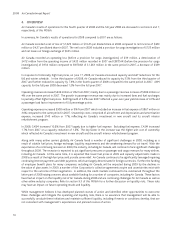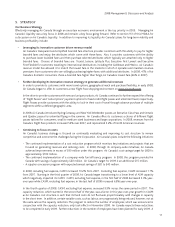Air Canada 2008 Annual Report Download - page 5
Download and view the complete annual report
Please find page 5 of the 2008 Air Canada annual report below. You can navigate through the pages in the report by either clicking on the pages listed below, or by using the keyword search tool below to find specific information within the annual report.
5
including a fourth quarter reduction of 7.8 per cent.
Our yields grew 4.3 per cent.
On the cost front, we held our unit cost increase
to 1.7 per cent, excluding fuel, despite flying fewer
available seat miles over which to spread our fixed
expenses. Moreover, we successfully achieved more
than $100 million in savings through a company-
wide austerity program. A similar initiative has
been undertaken this year with a target of more
than $120 million in cost savings.
Overall, our strategies to generate incremental
revenue and reduce costs enabled us to offset half
of the $867 million increase in our 2008 fuel bill
over that of 2007.
One significant endorsement our company
received late last year came from the lending
community. Despite tight credit markets around
the world, in recent months Air Canada successfully
negotiated several arrangements to secure
approximately $641 million in new financing as
well as $50 million in additional available credit.
As a result, we ended the year with approximately
$1 billion in cash, cash equivalents and short-term
investments.
In 2009 we will continue to focus efforts on
maintaining a strong cash position balanced
against appropriate debt levels and work to
further strengthen the company financially. While
credit markets remain difficult, we are guardedly
optimistic about new financing opportunities.
At year-end Air Canada owned aircraft and other
assets which, based on current values, may support
additional financings of up to $1 billion. , However,
this comes with the caveat that market conditions
make it difficult to determine the amount of
financing that can be generated on the basis of
these assets and the financing costs that would be
incurred by Air Canada.
Closely tied to the liquidity issue are the
company’s pension plans. Air Canada administers
a number of defined benefit pension plans which,
despite $456 million in company contributions
in 2008, and based on preliminary estimates
and factors described in our 2008 results, had
a combined solvency deficit of approximately
$3.2 billion at year end due to the downturn in
capital markets where these funds are invested.
Under current regulations the company is facing
significant payments in the coming years for
current and past service funding requirements.
Air Canada remains committed to its pension
plans. However, like other federally-regulated
companies with defined benefit plans, it is seeking
measured changes to bring pension funding
regulations in line with those in other jurisdictions.
Our company has engaged with other major
Canadian corporations in a dialogue with the
Canadian federal government on pension funding
relief. We believe it is imperative for the federal
government to enact permanent changes to federal
pension regulations that would make pensions
more secure and help companies compete more
effectively in the global economy.
Another important event in 2009 at Air Canada
will be labour negotiations as the contracts for
all major unionized employee groups expire this
year. Management has made sustained efforts
to develop a rapport with the company’s unions
and build trust based on respect, transparency
and clear understanding. Both the company and
its employees share the common interest of
preserving Air Canada as a strong, viable airline
and I remain optimistic that the parties can work
together to conclude fair and reasonable collective
agreements to achieve this mutual goal.
While the year ahead promises to be difficult,
we have grounds to believe Air Canada is well


